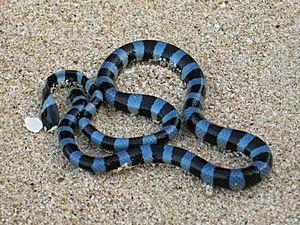Blue-lipped sea krait facts for kids
Quick facts for kids Blue-lipped sea krait |
|
|---|---|
 |
|
| Conservation status | |
| Scientific classification | |
| Genus: |
Laticauda
|
| Species: |
laticaudata
|
| Synonyms | |
|
|
The blue-lipped sea krait, also known as the blue-banded sea krait or common sea krait (Laticauda laticaudata), is a type of venomous sea snake. It belongs to the family called Elapidae. These snakes live in the warm waters of the Indian and Western Pacific Oceans. They are unique because they spend time both in the ocean and on land.
Contents
What's in a Name?
Scientists give every living thing a special two-part name. This helps everyone know exactly which animal they are talking about. The blue-lipped sea krait was first described by a famous scientist named Carl Linnaeus in 1758. He gave it the name Coluber laticaudatus.
Different Types of Blue-Lipped Sea Kraits
Just like there can be different types of dogs, there are also different types of blue-lipped sea kraits. Scientists call these "subspecies." For this snake, there are two known subspecies:
- Laticauda laticaudata laticaudata
- Laticauda laticaudata affinis
What Does It Look Like?

The blue-lipped sea krait has a body that is usually dark gray or black. It has many lighter bands that go all the way around its body. These bands are often yellowish or bluish-gray.
One special feature is its upper lip, which is dark brown. This helps tell it apart from other similar sea snakes. Its body scales overlap, like roof tiles.
How Big Do They Get?
Male blue-lipped sea kraits can grow to about 91 centimeters (about 3 feet) long. Females are a bit longer, reaching about 107 centimeters (about 3.5 feet). Their tails are shorter, usually around 11 centimeters (about 4 inches) long.
Where Do They Live?
This sea snake lives in a wide area across the Indian and Western Pacific Oceans. You can find them in places like:
- The Bay of Bengal (near countries like Bangladesh, India, and Myanmar)
- Coasts from Malaysia to Indonesia and the Philippines
- Near Japan, Taiwan, and parts of China
- Islands in Polynesia, Melanesia, and the Solomon Islands
- Countries like New Caledonia, Vanuatu, and Fiji
- Off the coast of Queensland, Australia
Sometimes, a blue-lipped sea krait might travel far from its usual home. For example, one was found in New Zealand in 2011, but it sadly did not survive.
Cool Facts About This Snake
These sea snakes are known to warm up in burrows made by a type of bird called the wedge-tailed shearwater. This helps them get warm after being in the cooler ocean water.
See also
 In Spanish: Krait de mar de bandas azules para niños
In Spanish: Krait de mar de bandas azules para niños


